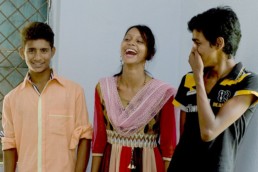Whether you agree with the Thomson Reuters poll (2018) or with the critics of the poll – you cannot deny that women are unsafe in India. We can debate whether India is first on the list, or fifth on the list, or tenth on the list of unsafe countries for women, but being on the list is bad enough.
We need to act fast to change this. It is extremely important to direct resources to empower women and girls to stand up for themselves, and it is equally important to equip men and boys with the understanding that it is not OK or natural to hit or rape.
Men are not naturally predisposed to being violent or discriminatory towards women and girls. Inter-generational transfer of inequitable gender-norms rooted in patriarchy plays a significant role in socialising some boys into growing up to be violent and discriminatory (Bolzendahl and Myers 2004, Flood and Pease 2009).
Levtov, Barker, Verma, et. al. (2014), administered the IMAGES survey to 10,490 males aged 18-59 across 8 countries, including India (in collaboration with CHSJ and ICRW). The results showed that men who reported a more equitable childhood home environment were more likely to have more equitable attitudes. This is a very important and powerful finding because it means that there is something WE can do! WE CAN raise boys to be gender-equitable, and consequently we can raise them to be non-violent and non-discriminatory human beings.
The situation could change rapidly if we focus on raising gender-equitable boys. Efforts to empower women and girls will encounter less resistance if their fathers, brothers, uncles, husbands, sons and male colleagues also have the opportunity to learn and practice gender-equitable behaviour. This is a critical piece of the puzzle to end violence and discrimination against women and girls in our societies, especially in India where most perpetrators of sexual violence tend to be known to the victims (Bhattacharya 2018).
In order to raise gender-equitable boys (and girls) we must identify, challenge and change discriminatory gender-norms and gender-roles. We must create home environments where both male and female partners participate in care-giving, earning, household chores and decision-making, which will lead to children internalising positive gender norms. We must create school environments where sports, subjects and careers are accessible irrespective of gender, which will reinforce gender-equality. And, we must change social messaging from “treat all women like your mothers and sisters” to “treat all women like human beings and respect their human rights,” which will enable boys to see themselves as collaborators and not protectors.
Whether we work with men to improve livelihoods, or with women on maternal health, nutrition and income generation, or with children on education and life-skills we must ensure that we also empower them to challenge and change inequitable gender-norms in their homes, communities and societies. This could take us a few steps closer to raising a generation of gender-equitable human beings and many steps away from such ignominious lists.
–Christina Furtado,
Executive Director, Equal Community Foundation
References:
Thomson Reuters Foundation (2018): “The Worlds Most Dangerous Countries for Women” http://poll2018.trust.org/
Bhattacharya, Pramit (2018): “India not most dangerous place for women: analysis” The Mint, 28 June 2018
Bolzendahl, C.I,. and D. J. Myers Writer (2004): “Feminist Attitudes and Support for Gender Equality: Opinion Change in Women and Men, 1974 – 1998.” Social Forces 83: 759-90. Chapel Hill, NC
Flood, M., and B. Peace (2009): “Factors Influencing Attitudes to Violence Against Women.” Trauma, Violence & Abuse 10: 125-42.
Levtov, R.G., G. Barker, M.Contreras-Urbina, B. Heilman and R. Verma (2014):”Pathways to Gender-Equitable Men: Findings from the International Men and Gender-Equality Survey in Eight Countries,” Men and Masculinities, published online on 6 Nov 2014, Sage Publications

